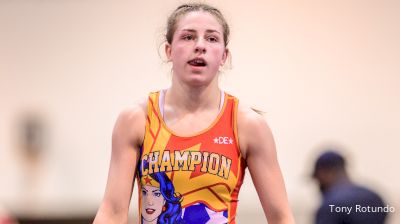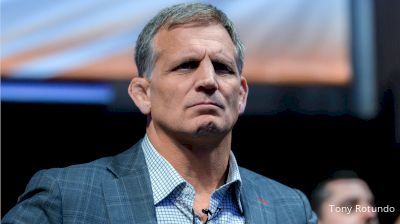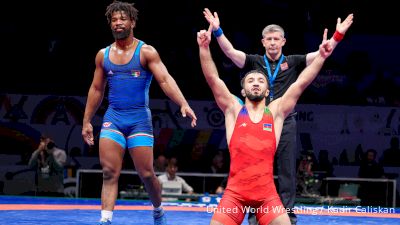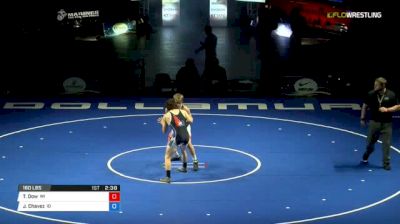USA Greco, An Upward Trend
USA Greco, An Upward Trend
Greco-Roman has made a resurgence in the United States in the last couple of years, and much of that is due to the implementation a clear plan set forth by USA Wrestling head coach Matt Lindland. The concept is simple: invest in the youth.
Greco-Roman has made a resurgence in the United States in the last couple of years, and much of that is due to the implementation a clear plan set forth by USA Wrestling head coach Matt Lindland.
The concept is simple: invest in the youth.
"You have to have the right athletes," Lindland said about cultivating young Greco wrestlers. "When I started this job I had to go find the right athletes -- guys like Kamal Bey, Tracy Hancock, and Mason Manville."
Lindland's wager on the emerging talent in the sport is starting to pay off. Before this past week's fourth-place finish in Tampere, Finland, the U.S. Greco program had not placed higher than 13th in the last 15 years of Junior Worlds competition.
As the United States' first Junior Greco world champion since 1999, Bey wowed the crowd with a super-charged brand of Greco that differs from the more conventional styles exhibited by some of the Scandinavian countries. Unlike many of his foreign Greco counterparts, Bey does not have a tendency to push his opponents toward the edge and make sure that most of the scoring happens out of bounds.
In five matches, Bey put up 52 points on the board behind his get-a-lock-and-go style.
When asked for the source of Bey's high-octane approach, Lindland said, "Kamal Bey is an artist. Kamal and I have similar philosophies in that we both want to put a product out there that is exciting and fun to watch. I put him positions, give him confidence (that he can score) in there, but he's the artist. He makes it happen."
Making improvements on the junior level is a great sign of things to come on the senior level, but Lindland knows that this is not the time to rest on your laurels.
"As team, as a country, we must stay the course in recruiting new athletes," he said. "I want the most passionate guys in our country to feel like they can follow their passion and go Greco. The concept used to be foreign, but we're starting to come around in the U.S."
Lindland specifically pointed to the 23 points allowed by Bey during his gold medal run as a potential area of improvement.
"As for some of our individuals, there are technical things that definitely need work," Lindland said. "Kamal won a world title, but he needs to work on not giving up as many points as he did."
While the USA's junior men's freestyle team will inevitably steal many of the headlines because it won a world team title, it's hard not to be impressed and encouraged by the women's and Greco-Roman teams. When you take a step back and look at the broader picture, it is obvious that the high water mark for Greco in this country is on the rise.
This encouraging trend was on display at the Cadet and Junior National Championships in Fargo, ND, last month. For years, many of the top Greco placers in Fargo have looked like athletes that were talented enough to win in both styles. However, this year the top tier at Fargo looked like "Greco guys."
"In the past while I was happy that guys were trying the sport, I was discouraged by the fact that the better Greco-Roman wrestler oftentimes lost," Lindland said about the upper echelon of Greco athletes in Fargo. "This year that was not the case."
The concept is simple: invest in the youth.
"You have to have the right athletes," Lindland said about cultivating young Greco wrestlers. "When I started this job I had to go find the right athletes -- guys like Kamal Bey, Tracy Hancock, and Mason Manville."
Lindland's wager on the emerging talent in the sport is starting to pay off. Before this past week's fourth-place finish in Tampere, Finland, the U.S. Greco program had not placed higher than 13th in the last 15 years of Junior Worlds competition.
As the United States' first Junior Greco world champion since 1999, Bey wowed the crowd with a super-charged brand of Greco that differs from the more conventional styles exhibited by some of the Scandinavian countries. Unlike many of his foreign Greco counterparts, Bey does not have a tendency to push his opponents toward the edge and make sure that most of the scoring happens out of bounds.
In five matches, Bey put up 52 points on the board behind his get-a-lock-and-go style.
When asked for the source of Bey's high-octane approach, Lindland said, "Kamal Bey is an artist. Kamal and I have similar philosophies in that we both want to put a product out there that is exciting and fun to watch. I put him positions, give him confidence (that he can score) in there, but he's the artist. He makes it happen."
Making improvements on the junior level is a great sign of things to come on the senior level, but Lindland knows that this is not the time to rest on your laurels.
"As team, as a country, we must stay the course in recruiting new athletes," he said. "I want the most passionate guys in our country to feel like they can follow their passion and go Greco. The concept used to be foreign, but we're starting to come around in the U.S."
Lindland specifically pointed to the 23 points allowed by Bey during his gold medal run as a potential area of improvement.
"As for some of our individuals, there are technical things that definitely need work," Lindland said. "Kamal won a world title, but he needs to work on not giving up as many points as he did."
While the USA's junior men's freestyle team will inevitably steal many of the headlines because it won a world team title, it's hard not to be impressed and encouraged by the women's and Greco-Roman teams. When you take a step back and look at the broader picture, it is obvious that the high water mark for Greco in this country is on the rise.
This encouraging trend was on display at the Cadet and Junior National Championships in Fargo, ND, last month. For years, many of the top Greco placers in Fargo have looked like athletes that were talented enough to win in both styles. However, this year the top tier at Fargo looked like "Greco guys."
"In the past while I was happy that guys were trying the sport, I was discouraged by the fact that the better Greco-Roman wrestler oftentimes lost," Lindland said about the upper echelon of Greco athletes in Fargo. "This year that was not the case."
Related Content
 All The Ranked Wrestlers At The Girls High School Showcase
All The Ranked Wrestlers At The Girls High School ShowcaseApr 23, 2024
 All The Ranked Wrestlers At The U17 World Team Trials
All The Ranked Wrestlers At The U17 World Team TrialsApr 23, 2024
 The NCAA Women's Freestyle Transfer Portal Is Open
The NCAA Women's Freestyle Transfer Portal Is OpenApr 23, 2024
 Ohio State Coach Tom Ryan Hospitalized After Car Wreck
Ohio State Coach Tom Ryan Hospitalized After Car WreckApr 23, 2024
 UWW Suspends Officials Involved In Chamizo - Bayramov Bout
UWW Suspends Officials Involved In Chamizo - Bayramov BoutApr 23, 2024
 2024 Olympic Wrestling Qualifiers
2024 Olympic Wrestling QualifiersApr 23, 2024
 How to Watch: 2024 Missouri USA Girls Freestyle State | Wrestling
How to Watch: 2024 Missouri USA Girls Freestyle State | WrestlingApr 23, 2024
 How to Watch: 2024 Missouri USA Boys Greco State | Wrestling
How to Watch: 2024 Missouri USA Boys Greco State | WrestlingApr 23, 2024
 How to Watch: 2024 Missouri USA Girls Greco State | Wrestling
How to Watch: 2024 Missouri USA Girls Greco State | WrestlingApr 23, 2024
